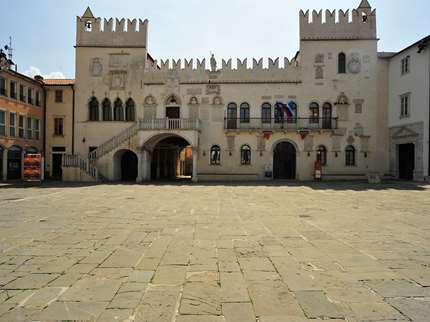Return
+386 (0)5 664 61 00 www.koper.si
The Praetorian Palace in Koper
The Praetorian Palace with its external staircase, two towers, a serrated finish and crests on the facade represents the most important profane structure in Koper.
Address:
Titov trg 1
Find on the mapAudio guide:
How to get there:
It is located on Tito Square, the central square in Koper.
The central town square, once the Platea comunis, then the Cathedral, and today Tito Square, is surrounded by the most significant town structures with rich history. Opposite the town loggia, on the southern part of the square, is the magnificent Praetorian Palace, the most important profane architectural structure in town with exceptional building history from the 13th until the 17th century. It was erected between two older mid 13th century houses, which first used to be connected by the loggia. During the second half of the century, the palace was renovated several times, primarily because it was destroyed by the Genoese attack. Finally, its present, two-storey appearance with external stars and two towers, one on the east and the other on the west wing, was completed in the second half of the 15th century. The dominating Late Gothic-Renaissance and the Venetian Gothic styles rank the palace among the top of the Slovenian profane architecture. Its spacious facade is intertwined by a row of double-, triple-, and quadruple lancet windows, the already mentioned stairs and the balcony above the semi-circular two pillar portal. The Renaissance portal, known as del Corte dates back to 1505. It was given its final appearance during the Baroque, when an impressive serrated finish was added in 1664 and the decorative coats of arms re-positioned on the facade. The lion shaped relief with an opening i.e. Bocca del Leone, was put on the facade corner. It was used for anonymous messages to Koper administrators. Following the fall of the Venetian Republic in 1797, the Praetorian Palace lost its significance. During the Austrian rule, all the functions were moved to the Armeria (arms storage). The structure was neglected until 2001, when it was renovated, and the town hall restored within its walls.





















